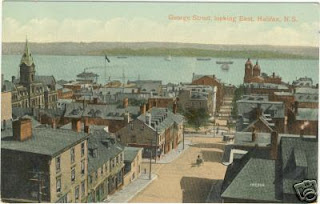This was during the 1940's when Canada was at war and gasoline was rationed, as were auto tires, and many other commodities. New cars were a fond dream that had to wait until the war ended.
I'm not saying these were better times, simply that for the most part a much smaller carbon footprint was being left by us all.

Milk was delivered by horse and wagon, and likely had been shipped no more than 60 miles from the dairy farms, and that shipment was by train, not a gas-guzzling tanker truck. Vegetables came to our door, again by horse and wagon from a farmer about 15 miles outside the city. Some shipped their produce in by train to a fruit and vegetable wholesaler on south Barrington Street by the railway tracks, some came in trucks or horse and wagon to the weekly market.
Baked goods came from the French Pastry shop around the corner, and there were several small grocery shops within a block or so, as well as a modestly sized Dominion Store and three small drugstores, each owned by the pharmacist . So it was possible to do shopping on foot rather than driving to the nearest mall or big box plaza.
At that time, the entire City of Halifax fit on the peninsula - it now sprawls as a regional municipality from Chester on the South Shore up to Ecum Secum on the Eastern Shore - hundreds of square miles of city, suburbs, satellite towns and villages and rural acreage- all attempting to be governed by one-size-fits-all laws and bylaws. What confusion!
Halifax in the 1940's was the largest city in the Atlantic Provinces with a population of less than 80,000.Its population today hovers around 300,000.
 Halifax in the 1940's
Halifax in the 1940'sPublic transport within the city was by electric trams, and smaller centres in the province were served by regular freight and passenger trains, plus bus services, as well as ships along the coast.
Our daily menus were governed by what foods were available locally at that time of year. In the winter we relied heavily on root vegetables and apples with the occasional bananas and oranges that came to us by boat from the south - the "Lady" boats that also provided a small number of cabins for those who could afford a winter vacation. No pricey "Love Boats" then, just a very practical adjunct to a necessary freight service!
Summer brought a wider choice with peas, beans, lettuce, beets and berries and cherries. Some peaches and pears were also grown locally.
Most meat was produced close to where it was bought - for example there was a pig farm on the outskirts of Halifax and its owner made a daily trip to city restaurants for their "swill" - he used a type of low slung heavy freight wagon called a sloven and drove a beautiful strawberry roan draft horse. Fish, of course, was readily available, and I recall, even in my mid-twenties, kids selling large mackerel at the roadside for 25 cents.
 Gorsebrook Golf Links, south of Inglis between Robie and Tower Road
Gorsebrook Golf Links, south of Inglis between Robie and Tower RoadThere were still many open spaces within the city limits and it was still safe enough to turn your children loose in the neighbourhood. I have fond memories of a semi-rural childhood observing nature down backlanes and open spaces along the railway cutting. The Northwest Arm was still clean enough to swim in though with an average temperature of 58F it was mostly kids and young adults who partook of that activity.
Each summer my mother and us kids boarded with a local family in a seaside house 25 miles down the coast and my father came down on weekends. Everyone, mom included, got a much needed rest as all was done for us - beds made, food cooked and served etc. All she had to do was ride herd on the kids.
I'm scratching my head and wondering when and how Canada and the United States started down the route of increasing complexity in trade, and increasing size in our carbon footprint, and how to tackle the gordian knot and tease out the more important occurences along this path and think them through.
I must add that the fuel most readily available was at that time Cape Breton coal and my memory of winter in Halifax was the permeating stink of coal smoke and the filthy residue on buildings in town. This is a definite negative in terms of health and ecological damage, so all was not rosy, just perhaps a little more sustainable. Nowadays when most mornings if I am descending from the North Mountain where I live to the Annapolis Valley floor there is a pall of blue smog over everything - the tail end of the smog from central North America's power plants, traffic and factories, which we have to breathe despite the fact that we didn't have anything to do with its making or the resultant prosperity. A bitter pill to swallow.
I can't help but think that our steadily increasing reliance post-war on an oil based economy was the number one step toward our current ecological and financial mess, and over the next few days will explore facets of this.




